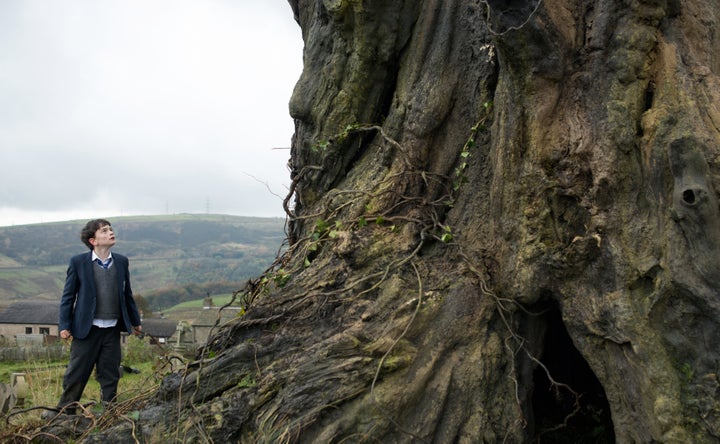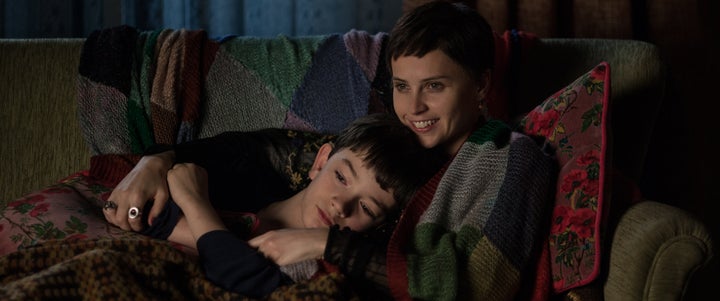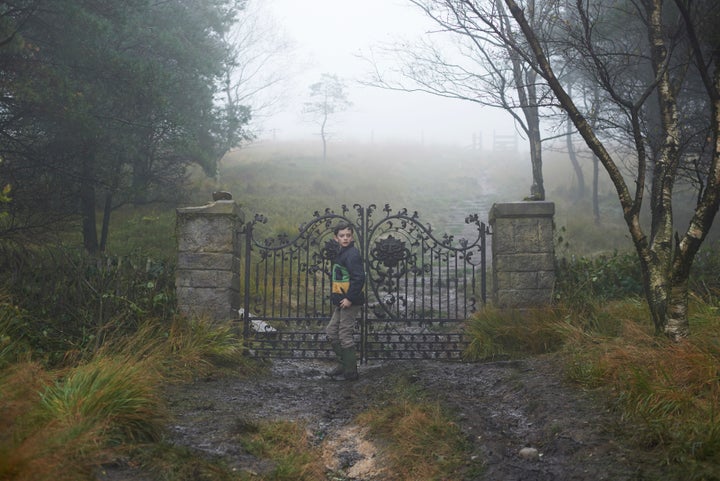
“A Monster Calls” begins with a nightmare. Against gray skies, the earth shakes. The ground of a vast cemetery splits open. Gravestones erupt and a chapel crumbles. A woman dangles over the edge of a chasm, her young son grabbing her hand as the tremors intensify. She is slipping from his grip, enveloped by the bottomless hole that threatens her life. He clings to the dwindling hope that his mother will survive the abyss. Seconds later, when the boy awakens in his bedroom, it is clear that this is not his first time dreaming of such a death. It haunts him like a recurring terror.
The boy, 12-year-old Conor O’Malley, suffers these nightmares because his single mother is terminally ill. Bullied at school and afraid he will be sent to live with his harsh grandmother, Conor needs a reprieve from her impending fatality. His sorrows, at the moment we meet him, are no dream. He can’t wake up expecting closure. What Conor needs is a spirit guide, a sensei who proffers wisdom that no one else will convey to him. At the very least, he needs a friend.
So, in J.A. Bayona’s new movie, currently premiering at the Toronto International Film Festival and based on Patrick Ness’ celebrated 2011 young-adult novel of the same name, Conor creates his own sensei. Having inherited his mother’s art skills, he sketches a colossal humanoid make of sticks and branches, as though a tree from his nightmare has sprung to life. While Conor draws, dreams meld with reality, and his creation rouses, stomping through the cemetery near his English home and marching up to Conor’s window. Imagine Treebeard from “The Lord of the Rings” or an articulate Groot from “Guardians of the Galaxy,” with the speech of a guttural Aslan from “The Chronicles of Narnia.” (Liam Neeson, who voices Aslan, also voices Conor’s monster.)

From there, “A Monster Calls” becomes a parable of resiliency. In my fall movie preview, I described its premise as “Where the Wild Things Are” meets “The BFG” meets “One True Thing.” My assumption was correct. Like the beasts Max meets in “Wild Things,” this gruff but compassionate monster could be a figment of Conor’s imagination, there to mentor his troubles. Or it could be an all-too-real wonderment from a dimension unknown to fussy adults. Every time the creature arrives, he clambers about with fanciful gusto and caustic wisdom.
The movie is photographed richly by Óscar Faura, who shot Bayona’s previous films, 2007’s “The Orphanage” and 2012’s “The Impossible.” But the endeavor falters in the interplay between Conor and his monster. We don’t spend enough time with the characters before the latter comes along, which is a particular shame because the movie’s performances are strong: Lewis MacDougall (”Pan”) is emotionally astute as Conor, Felicity Jones gives lively heft to the role of his dying mother, and Sigourney Weaver is reliable as his grandmother, even if her character is underdeveloped.

When the monster arrives, he tells Conor he will help by relaying three fables, all meant to convey morals about the malleable nature of good and evil. Put simply, life is harsh, and we all ― even bullies and grandmothers ― wrestle with the desire to be decent and the urge to be cruel. Each story ― told on individual visits when the clock strikes 12:07 a.m. ― is depicted with sumptuous watercolor animation, reminiscent of Hermione Granger’s “Tale of Three Brothers” homily in the penultimate “Harry Potter” film. Unfortunately, the monster’s little yarns are not that compelling. Each feels like a further diversion from the core story. We are denied crucial time with the characters, left with miniature films whose Very Important Messages the creature defines in blunt terms. It kills some of the impact of the metaphor, the idea that a childlike imagination can taper our woes. Conor doesn’t want to hear these stories, so by the time he’s fed their significance, the audience is manipulated into heartache for a character nearing her death bed.
Yet “A Monster Calls” pulls itself together by the end. The monster demands a tale from Conor, specifically one that represents “the truth.” Having convinced himself his mother would heal, how does Conor finally face the hard inevitabilities he’s avoided? It’s in that discovery that the movie redeems some of the fantastical wonder that made “Where the Wild Things Are” such an imaginative feast. It’s a shame we must travel a circuitous path to arrive there, but it turns out the monster and Conor land at a pretty good conclusion about this thing called life: If we grasp its complications and accept that not every story has a hero and a villain, we might realize the simplest reality of all is love.
“A Monster Calls” opens in theaters on Dec. 23.
CORRECTION: A previous version of this article misspelled a character’s name as Connor.

